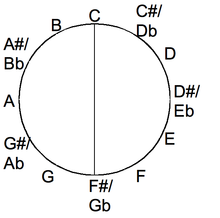Tritone
However, in the above-mentioned naming convention, they are considered different notes, as they are written on different staff positions and have different diatonic functions within music theory.In other meantone tuning systems, besides 12 tone equal temperament, Aug 4 and dim 5 are distinct intervals because neither is exactly half an octave.[17]Harry Partch has written: Although this ratio [45/32] is composed of numbers which are multiples of 5 or under, they are excessively large for a 5-limit scale, and are sufficient justification, either in this form or as the tempered "tritone", for the epithet "diabolic", which has been used to characterize the interval.In all of the sonorities mentioned above, used in functional harmonic analysis, the tritone pushes towards resolution, generally resolving by step in contrary motion.The tritone is a restless interval, classed as a dissonance in Western music from the early Middle Ages through to the end of the common practice period.Andreas Werckmeister cites this term in 1702 as being used by "the old authorities" for both the tritone and for the clash between chromatically related tones such as F♮ and F♯,[23] and five years later likewise calls "diabolus in musica" the opposition of "square" and "round" B (B♮ and B♭, respectively) because these notes represent the juxtaposition of "mi contra fa".[24] Johann Joseph Fux cites the phrase in his seminal 1725 work Gradus ad Parnassum, Georg Philipp Telemann in 1733 describes, "mi against fa", which the ancients called "Satan in music"—and Johann Mattheson, in 1739, writes that the "older singers with solmization called this pleasant interval 'mi contra fa' or 'the devil in music'."[25] Although the latter two of these authors cite the association with the devil as from the past, there are no known citations of this term from the Middle Ages, as is commonly asserted.[27]That original symbolic association with the devil and its avoidance led to Western cultural convention seeing the tritone as suggesting "evil" in music.At any rate, avoidance of the interval for musical reasons has a long history, stretching back to the parallel organum of the Musica Enchiriadis.For instance, in the tritone B–F, B would be "mi", that is the third scale degree in the "hard" hexachord beginning on G, while F would be "fa", that is the fourth scale degree in the "natural" hexachord beginning on C. Later, with the rise of the Baroque and Classical music era, composers accepted the tritone, but used it in a specific, controlled way—notably through the principle of the tension-release mechanism of the tonal system.[28] It is only with the Romantic music and modern classical music that composers started to use it totally freely, without functional limitations notably in an expressive way to exploit the "evil" connotations culturally associated with it, such as Franz Liszt's use of the tritone to suggest Hell in his Dante Sonata: —or Wagner's use of timpani tuned to C and F♯ to convey a brooding atmosphere at the start of the second act of the opera Siegfried.In his early cantata La Damoiselle élue, Debussy uses a tritone to convey the words of the poem by Dante Gabriel Rossetti.Roger Nichols (1972, p19) says that "the bare fourths, the wide spacing, the tremolos, all depict the words—'the light thrilled towards her'—with sudden, overwhelming power.The tritone was also exploited heavily in that period as an interval of modulation for its ability to evoke a strong reaction by moving quickly to distantly related keys.[32] In some analyses of the works of 20th century composers, the tritone plays an important structural role; perhaps the most cited is the axis system, proposed by Ernő Lendvai, in his analysis of the use of tonality in the music of Béla Bartók.[34] John Bridcut (2010, p. 271) describes the power of the interval in creating the sombre and ambiguous opening of the War Requiem:[35] "The idea that the chorus and orchestra are confident in their wrong-headed piety is repeatedly disputed by the music.From the instability of the opening tritone—that unsettling interval between C and F sharp—accompanied by the tolling of warning bells ... eventually resolves into a major chord for the arrival of the boys singing 'Te decet hymnus'.[37][38] George Harrison uses tritones on the downbeats of the opening phrases of the Beatles songs "The Inner Light", "Blue Jay Way", and "Within You Without You", creating a prolonged sense of suspended resolution.[39] Perhaps the most striking use of the interval in rock music of the late 1960s can be found in Jimi Hendrix's song "Purple Haze".According to Dave Moskowitz (2010, p. 12), Hendrix "ripped into 'Purple Haze' by beginning the song with the sinister sounding tritone interval creating an opening dissonance, long described as 'The Devil in Music'.






Tritone (disambiguation)The Devil's ChordInverseSemitonesInterval classJust intervalJust intonationmusic theorymusical intervalwhole tonesdiatonic scaleoctaveC majorscale degreesclassical musicdissonanceharmonytonalitydominant seventh chordtritoniaatritoniamusical scaletritonicatritonicenharmonically equivalentchromatic scalestaff positionswideningperfect fourthnarrowingperfect fifthchromatic semitoneperfect octavetuning systemequivalentmajor secondminor seconddiminished secondpiano keyboardchromatic circletuning systemsincomposite intervalsperfect fourthsperfect fifthsjust augmented fourthmeantoneseptimal meantone temperament31 equal temperamentquarter-comma meantonediesis5-limit tuningmajor scale7-limitseptimal tritonealphornsBrahmsFirst Symphonynatural hornBrittenSerenade for tenor, horn and stringsIvan Wyschnegradskymajor fourthPaul Hindemithsuperparticular ratiosHarry PartchtemperamentPythagorean ratiominor scaleC minorSupertonicaugmented sixth chordsA minordiminished triadhalf-diminished seventh chorddiminished seventh chordninth chordscontrary motionrenaissanceLocrian modetritone paradoxClaude DebussyPrélude à l'après-midi d'un fauneMiddle Agescommon practiceGuido of ArezzohexachordalUgolino d'OrvietoTinctorisAndreas WerckmeisterJohann Joseph FuxGradus ad ParnassumGeorg Philipp TelemannJohann MatthesonDenis ArnoldexcommunicatedorganumMusica Enchiriadishexachordstonal systeminversionRomantic musicmodern classical musicFranz LisztDante SonataWagnerSiegfriedLa Damoiselle élueDebussyDante Gabriel RossettiRoger Nicholsmodulationdistantly related keysHector BerliozLa damnation de FaustPandaemoniumJulian Rushtontwelve-tone musicserialismaxis systemErnő LendvaiBéla BartókGeorge CrumbBenjamin BrittenWar RequiemLeonard BernsteinWest Side Story